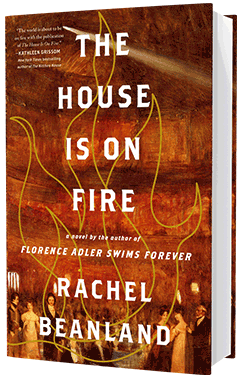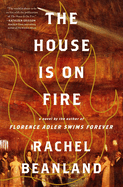The House Is on Fire
by Rachel Beanland
In Rachel Beanland's powerful second novel, The House Is on Fire, the Richmond Theater Fire of 1811--one of the deadliest events in early U.S. history--has personal ramifications for four protagonists, but also provokes public mourning and vengefulness. Moving at a propulsive pace, the novel rotates through the perspectives of these main characters--two men and two women; two white people and two enslaved Black people--caught up in the tragedy and its aftermath.
On December 26, 1811, the Virginia theater hosted a double bill: a translation of Denis Diderot's play The Father, followed by a pantomime. Just after the first act of the pantomime, a lit chandelier was lifted into the wings, setting the backdrops and rafters ablaze. It was at this point that the cry went up: "The house is on fire!"
Before this moment of crisis comes, Beanland introduces each of the key players. First, readers meet Sally Campbell, a daughter of statesman Patrick Henry and 31-year-old widow--her husband, Robert Campbell, a Scottish tobacco merchant, died recently. With her brother- and sister-in-law, Archie and Margaret, she takes her place in a third-floor box. From the private glamour of the boxes, readers descend to the second-floor gallery, where enslaved Blacks, freedmen, drunks and prostitutes sit. Nineteen-year-old Cecily Patterson is a house slave who must cater to 16-year-old Maria Price's every whim--and submit to Maria's older brother Elliott's sexual appetites. Tonight, she is serving as Maria's chaperone to the theater, and finds herself seated beside "the most heavily made-up whore she's ever encountered."
Meanwhile, Gilbert Hunt exits a Baptist meetinghouse and passes the theater on his way to the Mayo-Preston estate to visit his wife, Sara, a slave in the kitchen house. He knows that Sara's charge, Louisa, is watching the play, so he hopes to steal a moment alone with his wife. Gilbert works hard as a blacksmith, saving up to purchase their freedom.
The fourth perspective is that of Jack Gibson, a 14-year-old stagehand with the Placide & Green theater company. There's a known problem with the pulley that raises the chandelier. Jack is so busy with his tasks, and then so rapt watching the performance, that he forgets to take the chandelier away before the forest scene begins. He can think of no way to lower the chandelier, snuff the lights and lift it back up while the scene is in progress. Despite Jack's protests, the manager orders him to raise the lit chandelier into the flyspace.
And the rest is history, as they say--the record shows 72 casualties, including Virginia's governor as well as six Black people--but Beanland fleshes out the story behind the numbers, allowing readers to feel the terror of being trapped in a burning building and to rage at the arbitrariness, or in some cases the injustice, of who survives and who perishes. Jack exits quickly via a stage door; Cecily is one of the first out of the gallery. But Sally and family find evacuating the boxes difficult. Margaret is nearly overcome in a stampede, and the central staircase collapses before they reach it. The only option is jumping out a third-story window.
Gilbert hears news of the fire and runs to help, catching a dozen white women as they jump out of the theater windows. His heroism contrasts with others' selfish jostling to save themselves. Sally is unscathed by her plunge from the third floor, but Margaret has a badly broken leg and is carried to the home of Mrs. Cowley, a Native American healer who tends to the burns and wounds of the many victims brought to her door. Beanland weaves in fascinating information about the limited medical knowledge of the time--all too often, doctors had to resort to amputation--here and in earlier parts of the novel, where the author writes of potions Sally took for infertility, and abortifacients used for unwanted pregnancies.
The novel takes place over just four days, from the night of the fire to the day of the collective funeral, while the theater company hopes to deflect blame by spreading a rumor that the fire was started by rioting slaves, and there is diverging newspaper coverage of the tragedy. The pace is brisk, with the point-of-view changes becoming more frequent after the fire breaks out, heightening the tension. Beanland makes clever use of theatrical metaphors, hinting that some of these characters will have surprising second acts, and that the fire will be just an intermission in Richmond's vibrant cultural life.
Painstakingly researched and full of historical detail and full-blooded characters, Beanland's (Florence Adler Swims Forever) novel dramatizes the range of responses to tragedy and how people rebuild their lives: Sally finds untapped wells of courage during the fire and after; Cecily sees in the chaos of the tragedy a chance for escape and freedom; Gilbert, the selfless hero, dreams of a life with Sara, yet is thwarted anew; Jack wavers over telling the truth.
The House Is on Fire is highly recommended to readers of Geraldine Brooks's March and Karen Joy Fowler's Booth. --Rebecca Foster








